Abstract
Backgrounds/Aims
Various factors have been reported as prognostic factors of non-functional pancreatic neuroendocrine tumors (NF-pNETs). There remains some controversy as to the factors which might actually serve to successfully prognosticate future manifestation and diagnosis of NF-pNETs. As well, consensus regarding management strategy has never been achieved. The aim of this study is to further investigate potential prognostic factors using a large single-center cohort to help determine the management strategy of NF-pNETs.
Methods
During the time period 1995 through 2013, 166 patients with NF-pNETs who underwent surgery in Samsung Medical Center were entered in a prospective database, and those factors thought to represent predictors of prognosis were tested in uni- and multivariate models.
Results
The median follow-up time was 46.5 months; there was a maximum follow-up period of 217 months. The five-year overall survival and disease-free survival rates were 88.5% and 77.0%, respectively. The 2010 WHO classification was found to be the only prognostic factor which affects overall survival and disease-free survival in multivariate analysis. Also, pathologic tumor size and preoperative image tumor size correlated strongly with the WHO grades (p<0.001, and p<0.001).
Conclusions
Our study demonstrates that 2010 WHO classification represents a valuable prognostic factor of NF-pNETs and tumor size on preoperative image correlated with WHO grade. In view of the foregoing, the preoperative image size is thought to represent a reasonable reference with regard to determination and development of treatment strategy of NF-pNETs.
Nonfunctioning pancreatic neuroendocrine tumors (NF-pNETs) are defined as pancreatic tumors of neuroendocrine origin without symptoms and secretion of symptom-related neuroendocrine peptide. Since they have no specific hormonal symptoms, the incidence of NF-pNETs is thought to be very low and while most are slow-growing, some with more aggressive biology may not present until they reach an advanced stage with a large mass, local invasion, and distant metastases.12 Previous studies have reported a high metastasis rate of NF-pNETs at initial detection ranging between 32% to 55%. But, with ongoing developments in imaging modalities over the last few decades, pancreatic neuroendocrine tumors (pNETs), particularly non-functioning ones, have been identified with increasingfrequency.3 One population-based study showed that the incidence of small NF-pNETs (≤2 cm) has increased more than seven-fold over the last 22 years.4 The NF-pNETs have a wide spectrum of clinical behaviors, ranging from those of benign nature with a favorable prognosis, to the more aggressive and highly malignant with extensive metastases. It has been suggested, in this particular context, that in the absence of evident signs of malignancy, typical pancreatic resections (i.e., pancreaticoduodenectomy and distal pancreatectomy) of NF-pNETs should be limited to the larger lesions.5 Tumor size was advocated as a sentinel prognostic factor for its preoperative malignancy predictive value. Most neoplasms measuring <2 cm are likely benign or intermediate-risk lesions, and only 6% of NF-pNETs measuring <2 cm are malignant when incidentally discovered.6
Any NF-pNET should be considered potentially malignant and treated accordingly. Surgery currently represents the preferred treatment for any localized pancreatic neoplasm, as surgical intervention corresponds to a significantly favorable survival benefit, even in cases of metastatic NF-pNETs.7 However, with increasing detection of small NF-pNETs which is known to have excellent outcome, it is now a matter of debate as to whether all small and asymptomatic lesions should be routinely, automatically resected.8 Currently, 2 cm is a widely used reference point in determining the need for more aggressive treatment. Some centers (prudently and exercising an abundance of caution), offer the option of an intensive imaging surveillance to patients who present with a high risk of morbidity or mortality for major pancreatic resection. There is, however, no long-term result documenting the successful (or less than successful) outcomes, or long-term therapeutic value, of surveillance as yet. Also, there is a lack of studies about any definite association between the imaging tumor size and other prognostic factors related to survival. Many retrospective analyses revealed the utility of prognostic factors of NF-pNETs, but differences of opinion persist. Moreover, no, consensus on management strategy has ever been achieved, and none exists at the present time.
We aimed to further investigate the prognostic factors using a large single-center cohort, and confirm the value of the imaging tumor size as a preoperative malignancy predictive factor to help determine the management strategy of NF-pNETs.
The patient cohort was derived from the Samsung Cancer Centre Registry. Those patients diagnosed with NF-pNETs who had undergone surgical resection at Samsung Medical Center during the period January of 1995 through December of 2013 were recruited to participate in this study. The NF-pNET was defined by neuroendocrine tumor in pancreas that lacks any clinical syndrome caused by excess hormonal secretion, independent of laboratory data. All functional, atypical and mixed tumors were disqualified and excluded. As well, those patients afflicted with multiple endocrine neoplasia Type 1 or von Hippel-Lindau disease (diagnosed by family history and with confirmation of genetic mutation) were excluded from the study. Clinicopathologic characteristics, imaging study results, follow-up surveillance data, and outcome of these patients were retrospectively analyzed. Relevant demographic and clinicopathological data was harvested and compiled from existing medical records. We analyzed the following outcome variables: Date of diagnosis, patient gender, age at diagnosis, presence of symptoms, preoperative imaging characteristics, imaging size by various modalities, primary pathologic tumor size, location, grade, presence of lymph nodes and distant metastases, margin status and type of surgical intervention. The main diagnostic tool used was computed tomography (CT). Other diagnostic imaging tools implemented included endoscopic ultrasound (EUS) and magnetic resonance (MR) imaging. The recurrence and disease survival data was collected for prognostic stratification.
The surgical strategy was based on the anatomical location of the tumor and oncologic criteria. The surgical resection of NF-pNETs was performed by four surgeons in hepato-biliary-pancreas division in Samsung Medical Center. The tpes of surgery performed included atypical pancreatic resections such as enucleation, and more typical forms of resection such as pancreaticoduodenectomies and distal pancreatectomies. Lymph node dissection was performed in accordance with any clinical suspicion of nodal metastasis, resection type and surgeon's opinion. In patients with synchronous liver metastases, simultaneous hepatic resection was performed when the tumor was considered resectable.
All available pathology slides were reviewed and histopathological classification and grades were revised, if necessary, by specialized pathologists. All of the NF-pNETs were reclassified according to the World Health Organization (WHO) classification, 2010 version. According to the WHO classification, all well-differentiated neoplasms are called “neuroendocrine tumors” and designated Grade I (G1) (mitotic count, <2/10 high-power field [HPF] and/or ≤2% Ki-67 index) or G2 (mitotic count, 2–20/10 HPF and/or 3%–20% Ki-67 index). All poorly differentiated neoplasms are called “neuroendocrine carcinomas” (NECs) and designated G3 (mitotic count, ≥20/10 HPF and/or ≥20% Ki-67 index).9101112
The distribution by tumor stage based on the seventh edition of the American Joint Committee on Cancer (AJCC) Tumor Node Metastasis Classification System was also evaluated. Patients were followed up every three to six months for the first five years postoperatively, and then annually thereafter. The actual follow-ups included clinical re-evaluations, laboratory tests, CT of the abdomen and chest radiography. A diagnosis of recurrence was based on imaging findings, with histological confirmation as deemed clinically appropriate.
Quantitative variables are expressed as mean with standard deviation or median, and compared using Student's t test or the Wilcoxon test, as appropriate. One-way ANOVA was performed first to compare variables associated with decade change. Qualitative variables are expressed as numbers with percentages, and compared with the χ2 or Fisher's exact test, as appropriate. The Pearson correlation and t-test are used to describe correlation and to examine the difference between the two methods. The parameter estimation of multiple linear regression model was reported. Overall survival rate was calculated from the day of surgery to the date of death or the end of follow-up period. Disease-free survival was calculated using the date of death or recurrence as the time of the terminal event. To estimate the association between eligible variables and mean survival time, the Kaplan-Meier test was applied together with the log-rank test for comparison of various groups. All variables with p<0.100 on univariate analysis, as well as variables believed to influence recurrence, were studied in multivariate analysis using Cox proportional hazard regression. An odd ratio (OR) was expressed with 95% confidence interval (CI). P<0.050 was considered statistically significant. Statistical analyses were performed in SPSS statistics version 21.0 (IBM, Armonk, NY, USA).
During the period January 1994 through December of 2013, 166 patients underwent surgical resection for NF-pNETs in Samsung Medical Center and the clinicopathologic characteristics of these patients are summarized in Table 1 and 2. The mean age of patients was 54±11.1 years. The proportion of the patients who were diagnosed incidentally was 63.9%, which exceeded the rate of symptomatic patients (36.1%). If the patient was symptomatic and complained, abdominal pain and/or other symptoms of abdominal discomfort were the symptoms most frequently reported. Jaundice and weight loss were documented in 5.4% and 3.6% of patients. Pancreatic head-located NF-pNETs were most commonly found (44.6%). The median tumor size measured by preoperative imaging was 2.1 cm (range 0.4–18.0). Fourteen patients were diagnosed with NF-pNETs measuring <1 cm (8.4%), 52 patients (31.3%) as 1 cm or larger and smaller than 2 cm, and 100 patients (60.2%) as 2 cm or larger tumor. Distant metastasis rate at diagnosis was 2.4% which was lower than that of other recent SEER data, or European series. These findings are summarized in Table 1.
The median pathologically measured tumor size was 2.3 cm (range 0.2–20.5) and the proportion of tumors measuring <1 cm, 1–2 cm, and ≥2 cm was 8.4%, 31.3%, and 60.2%, respectively. Nearly 40% of patients had tumors smaller than 2 cm. The tumors were classified according to the 7th AJCC grading system. Sixty-nine patients (41.6%) had tumors classified as pathologic T1 stage, 39 (23.5%) as T2, and 58 (34.9%) as T3. The T4 stage was excluded because of non-resectability. In pathologic N staging, 78 patients (47.0%) had no pathological documented lymph node (LN) metastasis (N0), 24 (14.5%) patients had LN metastasis (N1). Sixty-four patients (38.6) were classified as “Nx”, meaning unknown LN metastasis status due to local excision of tumor or pancreatectomy without LN dissection. There were only two patients of local recurrence in Nx group without distant metastasis; one patient had surgical margin positive and one patient had G3 NF-pNETs originating from the uncinate process (which underwent only mass excision). There were 24 patients (14.5%) with pathologically proven regional LN metastasis, and four patients (2.4%) with distant metastasis, which were all liver metastasis. Radiofrequency ablation was performed in one case, and associated liver resection was performed in three cases of liver metastatic cases. Pathologic analysis showed that of 166 NF-pNETs, 82 tumors (49.4%) were G1, 72 (43.4%) were G2, and 12 (7.2%) were G3, based on the 2010 WHO classification. These are summarized in Table 2.
The median follow-up was 46.5 months with a maximum 217 months. The five-year overall survival and disease free survival rates were 88.5% and 77.0%, respectively. The prognostic factors affecting overall survival (OS) and disease-free survival (DFS) are listed in Table 3 and 4. In univariate analysis, asymptomatic tumors, T1/2, N0 or Nx status, pathologic or imaging tumor size <2 cm, and lower WHO grade were associated with significantly better OS rate. Through multivariate analysis, asymptomatic tumor and lower WHO grade were identified as independent prognostic factors for better OS. Univariate analysis demonstrated that symptomatic NET, head located tumor, higher 2010 WHO classification, higher TNM stage, N1 status, distant metastasis, pathologic or imaging tumor size ≥2 cm were associated with early recurrence. In multivariate analysis, higher WHO classification and N1 stage were the only risk factors for worse DFS.
The OS and DFS curves influenced by WHO classification are depicted in Fig. 1. The median OS of grade 1 tumor was 212.8 months (range: 204.8–220.9), 159.8 months (range: 135.9–183.6) for grade 2, and 15.3 months (range 9.7–20.9) for grade 3. The 5-year survival rates of grade 1 and grade 2 tumors were excellent with 97.5% and 87%, respectively. In contrast, none of the patients with grade 3 tumors survived more than 29 months, and the two year survival rate was 16.9%. There was statistically significant difference in OS among grade 1, grade 2, and grade 3; the p-value of each comparison was lower than 0.001. The median DFS of NF-pNETs was 172.7 months (range: 158.8–186.6) in grade 1, 133.2 months (range: 108.7–157.8) in grade 2, and 7.1 months (range: 5.4–8.8) in grade 3. All patients with grade 3 were diagnosed with tumor recurrence before twelve months had passed postoperatively. The five-year DFS rate of patients with grade 1 and grade 2 tumors was 98.6% and 61.3%, respectively. There was also a significant, documented difference in DFS among grade 1, grade 2 and grade 3 (p<0.001).
The 2010 WHO classification was the only prognostic factor shown to affect OS and DFS in multivariate analysis. The further analysis of relationship between other well documented clinical and pathologic prognostic factor and WHO grade was performed and is summarized in Table 5. There was a higher proportion of symptomatic patients, and head-located tumors, documented in higher Grades (p<0.001, p=0.008). The tumors with high WHO classification has more T3, N1 lesion (p<0.001, and p<0.001). The M stage has not been shown to have significant correlation with WHO classification (p=0.084). The pathologic tumor size correlated strongly with the WHO grades (p<0.001). All fourteen patients who had tumors less than 1 cm had Grade 1 tumors. There were no Grade 3 tumors in patients with small tumor less than 2 cm. The tumor dimensions as measured by preoperative imaging also correlated significantly with the WHO grades (p<0.001). A composition of patients grouped by imaging size was almost same as those grouped by pathologic size. The pathologic tumor size and the dimensions as evaluated by the imaging modalities (CT, MRI and EUS) showed excellent correlation (R=0.962, p<0.001). Pearson correlation coefficient of CT, MR, and EUS was 0.961, 0.903, and 0.913, respectively; and imaging size measured by CT has the most value, in terms of accuracy, with pathologic tumor size (Table 6).
The malignant potential of NF-pNETs is difficult to predict, and the natural history of these tumors is not fully understood. In addition, the slow growth of NF-pNETs and the incomplete establishment of accurate prognostic factors makes the management of NF-pNETs even more problematic. So, there is no standard strategy for NF-pNETs in particular yet. Most studies advocate surgical resection as the only curative treatment for NF-pNETs of any size, as it has been traditionally believed that even small tumors can be malignant or metastasize to lymph nodes.41314 But, considering the risks of pancreatectomy is also important. Typical pancreatic resections are associated with a high incidence of perioperative complications such as pancreatic fistula, and exocrine and endocrine insufficiency.15 Previous studies showed the incidence of new-onset diabetes after distal pancreatectomy as 9–36%.1617 Therefore, ideally, the choice between close observation and surgical resection should be based on an accurate estimate of malignancy in these tumors. In this respect, identifying proper prognostic factors is imperative to for the purpose of establishing informed, practical and adequate treatment strategies for these patients.
Many studies have endeavored to find and identify prognostic factors of NF-pNETs. There are many reports on prognostic factors but with much diversity. Tumor size, differentiation grade, Ki-67 index, and lymph node metastases are some examples of frequently noted prognostic factors.18192021 It is difficult to find consistent prognostic factors, but histologic grade, especially the WHO grade is an often indicated prognostic factor. Cherenfant et al.,22 in an analysis of 128 patients of at four institutions, identified age over 55, higher WHO histologic grade, and distant metastasis to be significantly associated with worse survival outcome. They found that patients with Grade 3 histology were six times more likely to die than patients with Grade 1 histology. Several other studies demonstrated similar findings.2324 In a review of patients with NF-pNETs who had undergone resection, they found that those with Grade 1 histology had five-year survival rate of 86% compared with 0% for patients with Grade 3 tumors. They concluded that Grade 3 histology was the most significant negative predictive factor for survival, and recommended that grade be an additional parameter of disease stage stratification.23
Our study identified presence of symptom and higher WHO grade to be independent prognostic factors associated with the OS rate. In terms of DSF, higher WHO grade and lymph node metastasis were each independently associated with recurrence. We note that the WHO grade was independently associated with both OS and DFS, but with tremendously large hazard ratios. Furthermore, presence of symptom and lymph node metastasis were all significantly different according to the WHO grade (p<0.001). An analysis using Kaplan-Meier's method demonstrated significant survival and recurrence discrimination according to the WHO grade of the tumors. These findings emphasize the weight and importance of the WHO grade in predicting the prognosis of patients with NF-pNETs in terms of both survival and recurrence.
If the WHO grade of NF-pNETs could be determined preoperatively, it would be of a great value in determining the prognosis and the development of informed, practical and successful treatment strategy. Evaluation by EUS-guided fine needle aspiration (EUS-FNA) may be useful for preoperative determination of the WHO grade. However, insufficient samples especially with small tumors,25 or an adverse event associated with EUS-FNA such as pancreatitis,26 preclude physicians from routine performance of EUS-FNA in every patient with NF-pNETs. Therefore, an alternative method to determine the WHO grade preoperatively needs to be investigated. In an attempt to address this problem, we performed an analysis to identify some clinical factors significantly associated with the WHO grade. The result showed that presence of symptoms, TNM stage, pathologic tumor size and the size dimensions as measured by preoperative imaging studies showed significant correlation with the WHO grades. Among these factors, the dimension of the tumor as measured by imaging study is an important factor, and which can be determined before surgery. The presence of symptoms is also significantly associated with the WHO grade however, symptoms tend to be considered “soft” findings as symptoms tend to be very subjective and on many occasions, very non-specific. Therefore, size, as determined by preoperative imaging studies is a good and objective means of predicting the WHO grade. With regard to the specific imaging tool which serves to produce the most consistent, precise and exact measure of size, the size of the tumor as measured by CT, MRI, EUS all showed excellent correlation with the actual, material tumor size as reported and documented through histologic examination in the current study (R=0.962, p<0.001).
According to our study, all 71 cases of small size NF-pNETs (<2 cm) were Grade 1 (81.7%) and Grade 2 (13.7%). It important to note is there were no Grade 3 tumors. Likewise, for tumors measuring less than 1 cm, all were found to be Grade 1 and there were no Grade 2 or Grade 3 identified. Therefore, we would suggest, with an abundance of caution, that small-size NF-pNETs (those measuring less than 2 cm) might be considered for observation with serial imaging studies (if there are no symptoms and no evidence of LN metastasis). Observation may be even more acceptable for tumors less than 1 cm. And, we found evidence that some NF-pNETs show late recurrence. Seven patients of Grade 1 and one patient of Grade 2 suffered late recurrences after five years. Too, it is noteworthy that among these eight patients, five patients experienced recurrence after ten years. It is thought that 4.8% of all patients experience late recurrence, therefore consideration of the possibility of recurrence and appropriate follow-up of surgically altered anatomy would strongly suggest that annual or biennial follow-ups, as well as follow-ups after five years, might be both medically advisable and medically justified.
There are limitations to this study. This data is retrospective and derived from a single institution and therefore might not be representative of any or all patient populations, given its relative diversity. To minimize the drawbacks caused by the retrospective nature of this study, we reviewed the pathologic grades and imaging studies with a dedicated pathologist and a radiologist. Nevertheless and the constraints notwithstanding, it is felt that additional prospective studies on a multicenter or multinational level are needed to obtain prognostic factors of even greater weight in terms of substantial medical evidence.
In conclusion, given the significant morbidity associated with the surgical resection of NF-pNETs, the identification of preoperative variables that can be implemented to determine which patients would be best served by close observation and which patients would benefit from curative surgical resection, is both warranted and necessary. In our study, the WHO grade was found to be a highly significant prognostic factor of overall survival, and pathologic tumor size was a relatively reliable predictor of WHO grade. However, because WHO grade and pathologic tumor size cannot be determined preoperatively, other factors associated with lower WHO grade might have to be implemented to determine the need for surgical intervention. Our study demonstrated that tumor size as measured by preoperative imaging correlated well with the pathologic tumor size. Because of this, preoperative image size is thought to represent a reasonable reference point to decide about informed and practical treatment strategies of NF-pNETs.
References
1. Bilimoria KY, Talamonti MS, Tomlinson JS, Stewart AK, Winchester DP, Ko CY, et al. Prognostic score predicting survival after resection of pancreatic neuroendocrine tumors: analysis of 3851 patients. Ann Surg. 2008; 247:490–500. PMID: 18376195.
2. Fischer L, Kleeff J, Esposito I, Hinz U, Zimmermann A, Friess H, et al. Clinical outcome and long-term survival in 118 consecutive patients with neuroendocrine tumours of the pancreas. Br J Surg. 2008; 95:627–635. PMID: 18306152.

3. Kishi Y, Shimada K, Nara S, Esaki M, Hiraoka N, Kosuge T. Basing treatment strategy for non-functional pancreatic neuroendocrine tumors on tumor size. Ann Surg Oncol. 2014; 21:2882–2888. PMID: 24740828.

4. Kuo EJ, Salem RR. Population-level analysis of pancreatic neuroendocrine tumors 2 cm or less in size. Ann Surg Oncol. 2013; 20:2815–2821. PMID: 23771245.
5. Aranha GV, Shoup M. Nonstandard pancreatic resections for unusual lesions. Am J Surg. 2005; 189:223–228. PMID: 15720996.

6. Bettini R, Partelli S, Boninsegna L, Capelli P, Crippa S, Pederzoli P, et al. Tumor size correlates with malignancy in nonfunctioning pancreatic endocrine tumor. Surgery. 2011; 150:75–82. PMID: 21683859.

7. Hill JS, McPhee JT, McDade TP, Zhou Z, Sullivan ME, Whalen GF, et al. Pancreatic neuroendocrine tumors: the impact of surgical resection on survival. Cancer. 2009; 115:741–751. PMID: 19130464.
8. La Rosa S, Klersy C, Uccella S, Dainese L, Albarello L, Sonzogni A, et al. Improved histologic and clinicopathologic criteria for prognostic evaluation of pancreatic endocrine tumors. Hum Pathol. 2009; 40:30–40. PMID: 18715612.

9. Klimstra DS, Modlin IR, Coppola D, Lloyd RV, Suster S. The pathologic classification of neuroendocrine tumors: a review of nomenclature, grading, and staging systems. Pancreas. 2010; 39:707–712. PMID: 20664470.
10. Rindi G, Klöppel G, Alhman H, Caplin M, Couvelard A, de Herder WW, et al. TNM staging of foregut (neuro)endocrine tumors: a consensus proposal including a grading system. Virchows Arch. 2006; 449:395–401. PMID: 16967267.

11. Pasaoglu E, Dursun N, Ozyalvacli G, Hacihasanoglu E, Behzatoglu K, Calay O. Comparison of World Health Organization 2000/2004 and World Health Organization 2010 classifications for gastrointestinal and pancreatic neuroendocrine tumors. Ann Diagn Pathol. 2015; 19:81–87. PMID: 25702616.

12. Araujo PB, Cheng S, Mete O, Serra S, Morin E, Asa SL, et al. Evaluation of the WHO 2010 grading and AJCC/UICC staging systems in prognostic behavior of intestinal neuroendocrine tumors. PLoS One. 2013; 8:e61538. PMID: 23620762.

13. Haynes AB, Deshpande V, Ingkakul T, Vagefi PA, Szymonifka J, Thayer SP, et al. Implications of incidentally discovered, nonfunctioning pancreatic endocrine tumors: short-term and long-term patient outcomes. Arch Surg. 2011; 146:534–538. PMID: 21576607.
14. Nomura N, Fujii T, Kanazumi N, Takeda S, Nomoto S, Kasuya H, et al. Nonfunctioning neuroendocrine pancreatic tumors: our experience and management. J Hepatobiliary Pancreat Surg. 2009; 16:639–647. PMID: 19365596.

15. Smith JK, Ng SC, Hill JS, Simons JP, Arous EJ, Shah SA, et al. Complications after pancreatectomy for neuroendocrine tumors: a national study. J Surg Res. 2010; 163:63–68. PMID: 20599224.
16. King J, Kazanjian K, Matsumoto J, Reber HA, Yeh MW, Hines OJ, et al. Distal pancreatectomy: incidence of postoperative diabetes. J Gastrointest Surg. 2008; 12:1548–1553. PMID: 18543045.

17. Shirakawa S, Matsumoto I, Toyama H, Shinzeki M, Ajiki T, Fukumoto T, et al. Pancreatic volumetric assessment as a predictor of new-onset diabetes following distal pancreatectomy. J Gastrointest Surg. 2012; 16:2212–2219. PMID: 23054900.

18. Strosberg JR, Cheema A, Weber JM, Ghayouri M, Han G, Hodul PJ, et al. Relapse-free survival in patients with nonmetastatic, surgically resected pancreatic neuroendocrine tumors: an analysis of the AJCC and ENETS staging classifications. Ann Surg. 2012; 256:321–325. PMID: 22415420.
19. Ellison TA, Wolfgang CL, Shi C, Cameron JL, Murakami P, Mun LJ, et al. A single institution's 26-year experience with nonfunctional pancreatic neuroendocrine tumors: a validation of current staging systems and a new prognostic nomogram. Ann Surg. 2014; 259:204–212. PMID: 23673766.
20. Boninsegna L, Panzuto F, Partelli S, Capelli P, Delle Fave G, Bettini R, et al. Malignant pancreatic neuroendocrine tumour: lymph node ratio and Ki67 are predictors of recurrence after curative resections. Eur J Cancer. 2012; 48:1608–1615. PMID: 22129889.

21. Krampitz GW, Norton JA, Poultsides GA, Visser BC, Sun L, Jensen RT. Lymph nodes and survival in pancreatic neuroendocrine tumors. Arch Surg. 2012; 147:820–827. PMID: 22987171.

22. Cherenfant J, Stocker SJ, Gage MK, Du H, Thurow TA, Odeleye M, et al. Predicting aggressive behavior in nonfunctioning pancreatic neuroendocrine tumors. Surgery. 2013; 154:785–791. discussion 791-793. PMID: 24074416.

23. Sellner F, Thalhammer S, Stättner S, Karner J, Klimpfinger M. TNM stage and grade in predicting the prognosis of operated, non-functioning neuroendocrine carcinoma of the pancreas--a single-institution experience. J Surg Oncol. 2011; 104:17–21. PMID: 21360536.

24. Pomianowska E, Gladhaug IP, Grzyb K, Røsok BI, Edwin B, Bergestuen DS, et al. Survival following resection of pancreatic endocrine tumors: importance of R-status and the WHO and TNM classification systems. Scand J Gastroenterol. 2010; 45:971–979. PMID: 20441530.

25. Bernstein J, Ustun B, Alomari A, Bao F, Aslanian HR, Siddiqui U, et al. Performance of endoscopic ultrasound-guided fine needle aspiration in diagnosing pancreatic neuroendocrine tumors. Cytojournal. 2013; 10:10. PMID: 23858320.

26. Katanuma A, Maguchi H, Yane K, Hashigo S, Kin T, Kaneko M, et al. Factors predictive of adverse events associated with endoscopic ultrasound-guided fine needle aspiration of pancreatic solid lesions. Dig Dis Sci. 2013; 58:2093–2099. PMID: 23423501.

Fig. 1
Kapalan-meier survival curves according to the Grade (WHO 2010 classification) are illustrated. (A) Overall survival after curative resection of NF-pNETs grouped according to the WHO Grade showed significant difference (p<0.001). (B) Disease free survival after curative resection of NF-pNETs also demonstrated significantly differences according the WHO Grade (p<0.001).
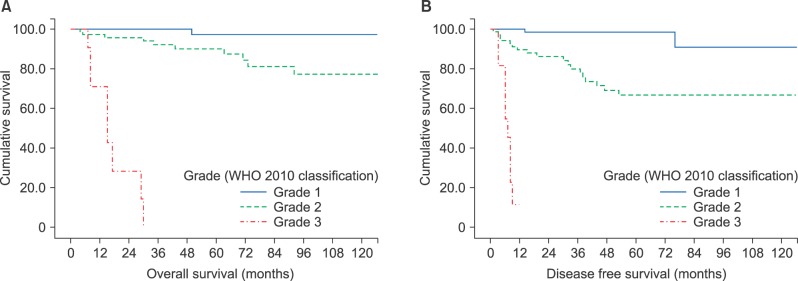
Table 3
Univariate analysis of prognostic factors affecting overall survival and disease free survival of NF-pNET patients
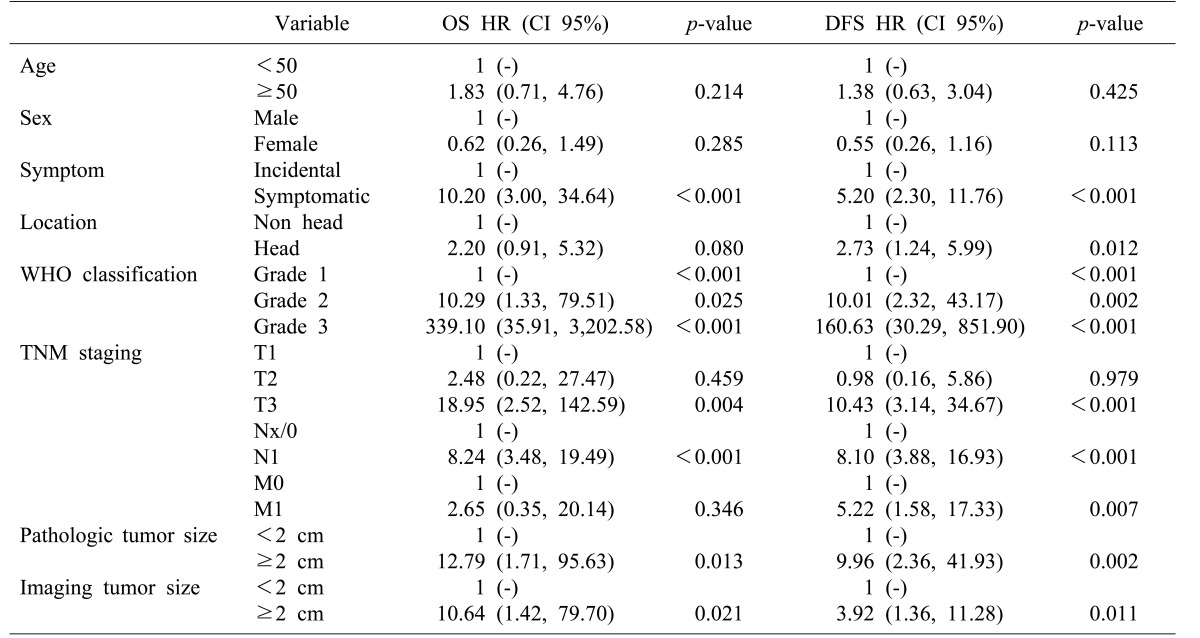




 PDF
PDF ePub
ePub Citation
Citation Print
Print


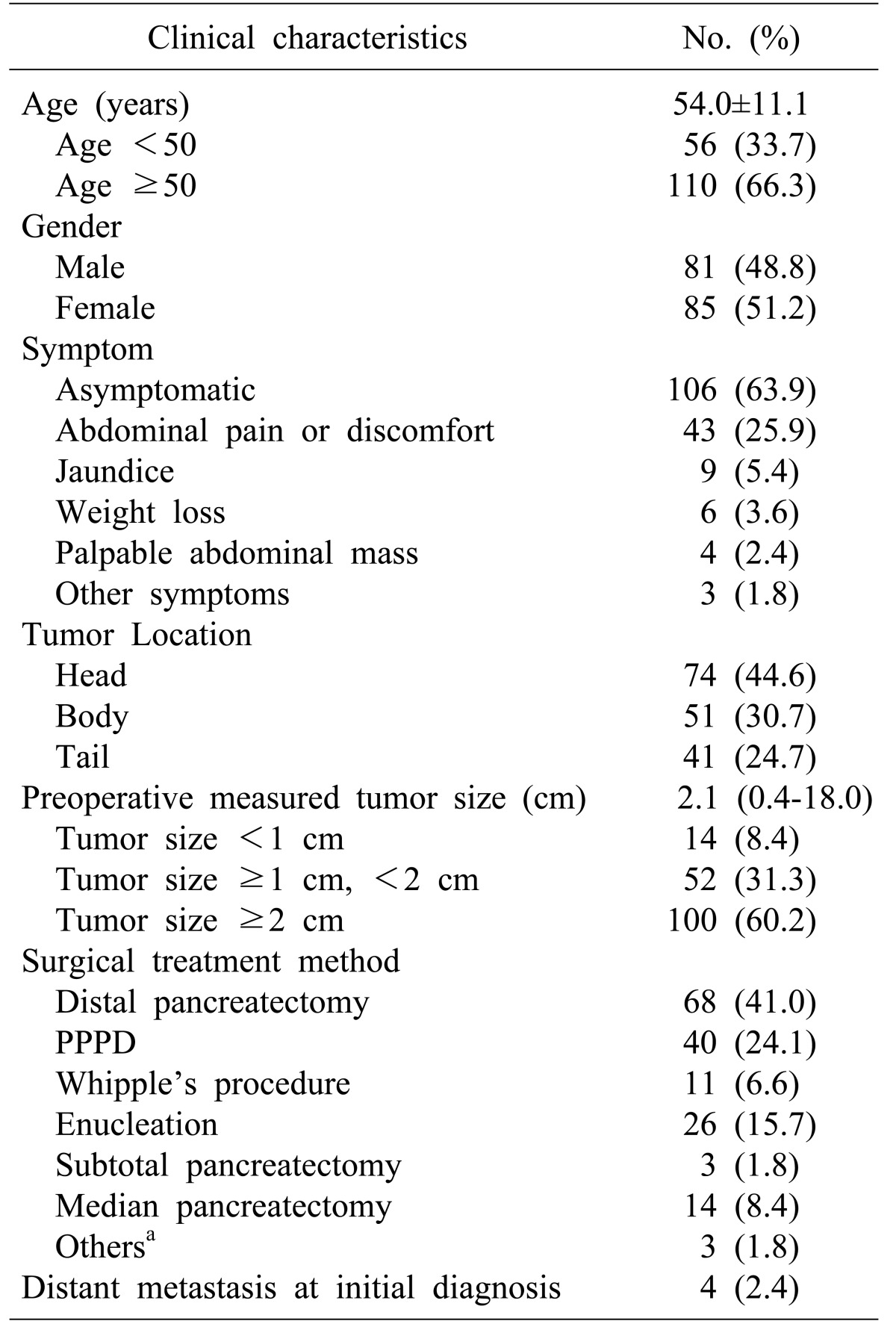
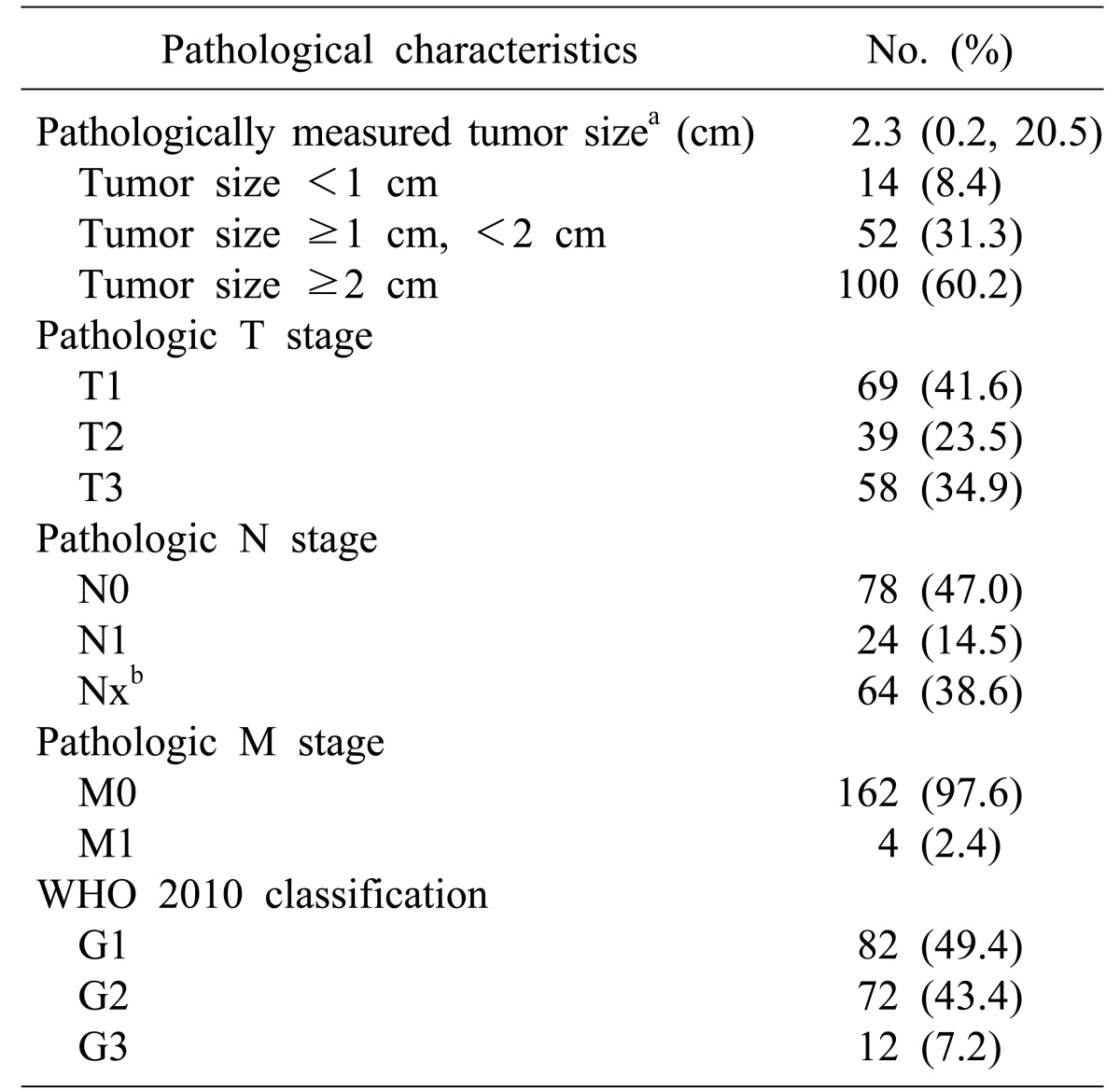

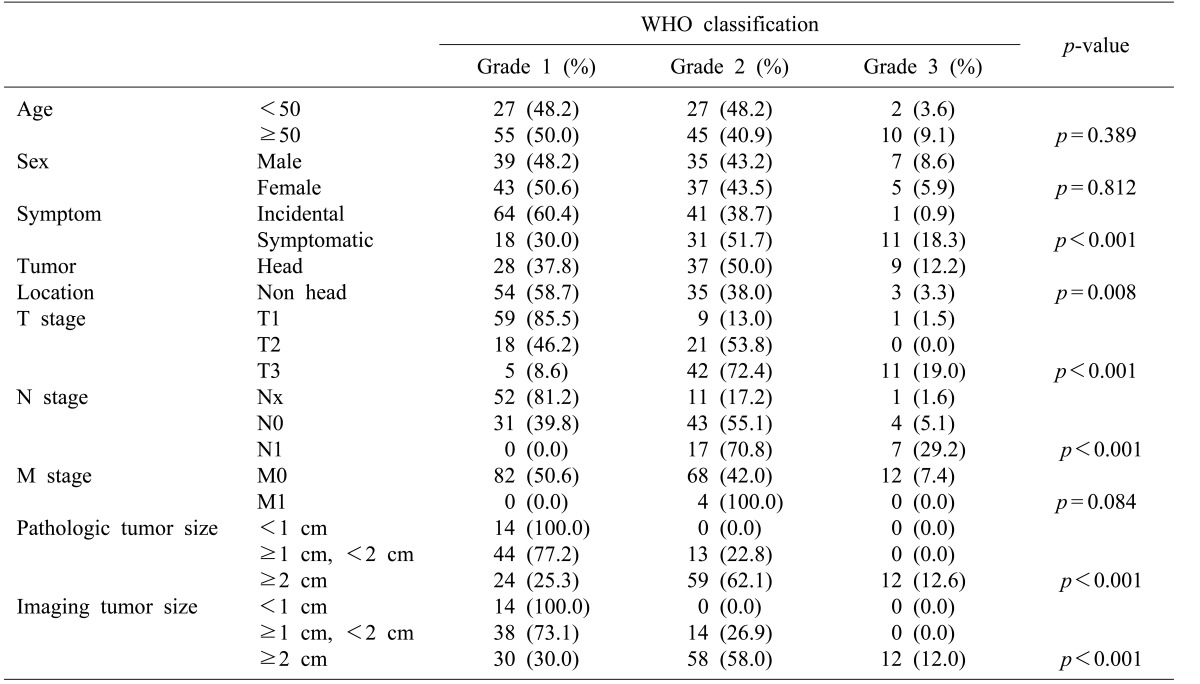

 XML Download
XML Download